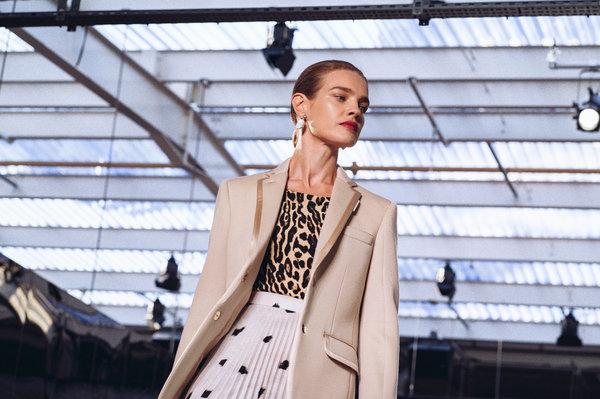In his debut for the house, Riccardo Tisci played with the brand’s codes and played it safe at the same time

Natalia Vodianova on the Burberry spring 2019 runway. CreditCreditTom Jamieson for The New York Times

In a cavernous former Royal Mail warehouse south of the Thames, where luxury developments were built in anticipation of an influx of foreign money that never materialized, and after a long buildup of teasers — a new, Pop-tastic Peter Saville logo; a $390 limited drop T-shirt; Beyoncé in bespoke wear at her recent concert in Houston — in a dark room divided into a maze of runways, Riccardo Tisci, the chief creative officer of Burberry, finally unveiled his first collection for the brand. There was not a single celebrity in the audience.
But still, the earth began to move.
Actually, that’s not true (though it was fun to write). It was the ceiling, as metal slats drew back to let the sunshine in. Fashion has never been afraid to embrace a somewhat obvious metaphor.
And what did the light illuminate?
It was a show in three acts (five, if you count the men’s and women’s divisions), officially titled “Kingdom,” though it could easily have been “Burberry As You Like It.” Beginning with Act 1: 50 shades of the British bourgeoisie, starring the trench.
Trenches came with wide, corset-like elasticated waists, and reinvented as an A-line skirt. They came lined in a signature plaid, and they came dangling pearls. They came with silk scarves emerging from the seams like ribbons, and mixed with logo-prints and swinging pleated skirts.
They came for men, along with neat structured tailoring and narrow trousers, pinstriped suits with contrast piping, and cross-body chains slinging umbrellas instead of swords across the back. The fabrics were lush, the accessories (belts! bags!) plentiful.

For the Burberry man, cross-body chains for slinging umbrellas across the back. CreditTom Jamieson for The New York Times
And that got them out of the way, proving that Mr. Tisci, who in previous incarnations at his own short-lived brand and at Givenchy, was known for a Gothic sensibility spiked with a grunge kick, as well as a Kardashian-Jenner social life, could do Sloane Square dressing with the best of them.
Thus allowing the curtain to come up on Act II: the youthquake part of the collection.
Which is to say a mash-up of Shakespeare (quotes, running like armbands around sleeves, splashed Barbara Kruger-like on shirts), the Sex Pistols (photo montages stuck onto the breast pockets like mechanic’s logos; “Who Killed Bambi” across a men’s leopard windbreaker), Victoriana (two black and white photo portraits) a cow print (because maybe countryside?), sweat shorts (for him) and shorter hemlines (for her).
Not to mention a new invention: the thigh-hugger. Imagine a strap attached to the bottom of men’s T-shirts, then drooping down to circle the upper leg, or sliced out of the hem of a miniskirt into two loops, its purpose unclear. Bondage, maybe.
A cow print, with a thigh strap. CreditTom Jamieson for The New York Times
So it went until Act III: evening. Back to polish. Long black dresses, cowl-backed or dangling gilt fringe, made for doing a languid waltz under the light of an enormous crystal chandelier.
Backstage after the show Mr. Tisci said he wanted to prove that Burberry wasn’t just about “one identity,” but rather could propose multitudes; could dress mothers and daughters, fathers and sons. And that to do this, he wanted to be free to celebrate all the layers that percolated through his mind when he thought about England (where he had lived for eight years, starting when he was 17, and where he went to fashion school and discovered his calling).
He did all that. What he did not do: nod to the English eccentric or Bloomsbury, a former pet theme of the house, now often hackneyed in expression. That was a relief.
Long, black evening dresses brought the show to an end.CreditTom Jamieson for The New York Times
Another thing he did not do: clothes with a gut punch of unexpected impact, the kind that make you jolt back in your seat in shock and delight.
This was, despite all its breath and references, an awfully safe beginning. The tweaking was in the details: the altered check, the blockier logo. Perhaps that’s understandable; the stakes are awfully high. All’s well that ends well, and so on.
But it was hard not to long, amid all the chic and street restraint, for a tempest.
Vanessa Friedman is The Times’s fashion director and chief fashion critic. She was previously the fashion editor of the Financial Times. @VVFriedman
Advertisement







